May 24, 2024
- Venison exports pie-chart now resembles the “peace symbol”
- Research continues to look at the road ahead, says Murphy
- Rainbows over the conference field day at Rangimoe
- Top deer vet wins 2024 Deer Industry Award
- Waipa’s “glue” wins the 2024 Matuschka Award
- Dancing Dundas Creek Stags wins top Deer Industry Photography Award
Venison exports pie-chart now resembles the “peace symbol”
The venison diversification programme is working to change the shape of exports, with the 2024 venison markets pie-chart now resembling the “peace symbol,” Rhys Griffiths told the conference audience.
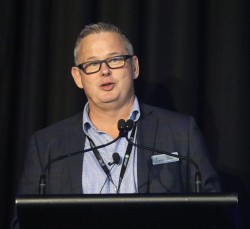
Rhys Griffiths, DINZ markets manager had a positive message for venison.
In the year-on-year to end February 2024, venison exports had lifted by around seven percent to $222 million from $208 million, with marketers now sending 39 percent of exports to the US, 28 percent to Europe and 23 percent to ‘other’ markets, including China. This compared to 2021’s figures when 58 percent was sent to Europe, 24 percent to the US and 18 percent to China and other.
Much of the DINZ’ venison marketing budget this year is focused on the US, “and we are still doing activity around foodservice”, he reported. Griffiths and assistant markets manager Virginia McConnell headed off straight after conference to the National Restaurant Association’s trade show in Chicago.
“We hope to get final sign-off by the Ministry for Primary Industries’ Sustainable Food & Fibre Fund (SFFF) by July on the industry’s North American Accelerator programme, which will give a further boost to activities there,” said Griffiths.
For Europe, the budget is almost fully devoted to chef support, with DINZ consultant chef Shannon Campbell’s services, “almost being fully utilised by the meat companies there.”
In Asia, DINZ assistant markets manager Virginia Connell is working closely with agency Tribal Brands Asia in China. Exploratory work has also been underway in Taiwan and Korea, delegates heard.
Research continues to look at the road ahead
Recent changes to approval systems for science projects have ensured that the deer industry’s balanced research portfolio continues to look ahead at what’s on the road in front of us, explained DINZ policy and research manager Emil Murphy.
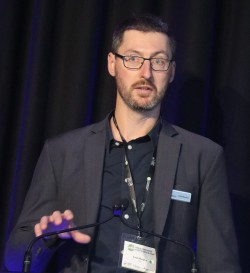
Emil Murphy speaking at conference.
Research is a long-standing work pillar for DINZ and “underpins all the work that we do,” Murphy told delegates.
“Over the past year, the DINZ board has confirmed our research strategy and its alignment with the overall business strategy. This is important to ensure a portfolio that delivers on industry’s needs. Having the board’s confirmation of the strategy gives us clarity about where we need to go,” he said.
The portfolio is balanced, according to Murphy, “not just across all venison, velvet, farm research and genetics, but also across time horizons.”
Research is now coordinated through the Research Advisory Panel (RAP), which recommends the research programme and priorities to the DINZ board subcommittee. RAP, which recently had its second meeting, is chaired by NZDFA-nominated environment consultant Danette McKeown. Other members include veterinarian Richard Hilson, breeder Dave Lawrence, retired academic Alastair Nichol, AgResearch’s Megan Skiffington, Rhys Griffiths (DINZ) and Sharon McIntyre (DeerSelect).
Farmer concern about the relationships between the deer industry and its main research provider AgResearch, as a result of the changes, was expressed via a remit to the NZDFA annual meeting.
In response, deer farmers have been assured that links between the industry and its research provider are sound.
“DINZ and AgResearch continue to work well together, both operationally and strategically at the board level. The changes in science strategy are really to make sure industry priorities are articulated and that research projects continue to align with industry strategy,” Murphy says. The addition of a board research sub-committee signals the importance of those research and industry relationships.
More information: Emil Murphy via email emil.murphy@deernz.org, or phone 027-251 3844.
More information is on the Research page of the DINZ website >>
Rainbows over the conference field day at Rangimoe
Rainbows lit up the Kereru sky for the big turnout of over 100 at the NZDFA Hawke’s Bay branch-hosted farm visit at the Gaddum family’s Rangimoe Station.
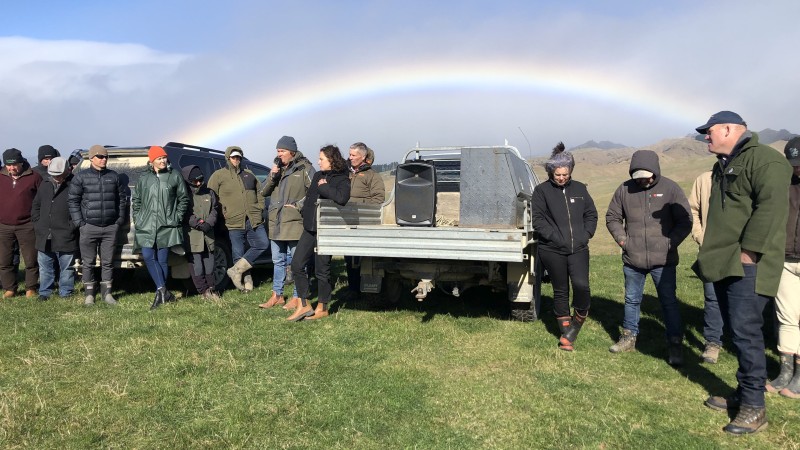
Ru and Kate Gaddum (centre) telling visitors about their Rangimoedeer unit under the rainbow, a symbol of hope and optimism.
Welcomed with coffee at the station’s yards, on an unexpectedly cold and blustery day, the visitors heard about the family’s multi-generation farming legacy at Kereru from Ben Gaddum. Then his son Ru and Kate Gaddum – the fifth generation of the family to farm Rangimoe – showed a convoy of 4x4s around the farm and its impressive deer unit, explaining the present and future for the property.
Around 2,406 deer are run over 456 effective hectares at Rangimoe, producing mainly for venison but with an expanding velvetting herd, alongside 1,095 sheep and 407 cattle.
Looking to the future, the Gaddums are working with Mauri Oho, the Northern Ruahine Biodiversity Recovery Project, on pest trapping and riparian re-planting of native plants on the property. Focused principally on Mauri Oho’s goal to recover populations of native whio ducks and kiwi in the area, a total of 34,000 plants have been established over the three years to date, along with eight kms of fencing.
The latest introduction to the Rangimoe deer herd – five Wapiti stags – have already been mated over 210 venison-type red hinds. Back at the farmyard, while visitors warmed up with hot drinks, they listened to a session facilitated by Richard Hilson of Vet Services. Deer breeder Dave Lawrence of Tikana Wapiti stud talked about breed genetics, then First Light’s Matt Gibson also told them about opportunities around wapiti-elk and the value chain for North American markets. More to come in Deer Industry News, due out in June.
Silver Fern Farms and First Light’s venison, beef and lamb products were served up for lunch, having been cooked on Silver Fern Farms’ mobile BBQ unit.
Thanks to Evan and Linda Potter and the rest of the NZDFA Hawke’s Bay branch team for being wonderful and outstanding hosts.
Top deer vet wins 2024 Deer Industry Award
Vet, university academic and contributor to a long list of deer veterinary science-related projects for more than 40 years, Professor Peter Wilson was honoured with the industry’s top trophy, the 2024 Deer Industry Award at the conference dinner, attended by 175.
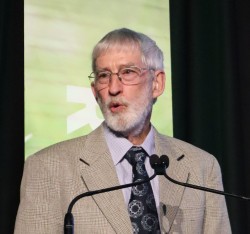
2024 Deer Industry Award winner, Professor Peter Wilson.
Founder of Massey University’s deer veterinary science teaching and research programme and deer research farm, Wilson has been “a source of factual information for deer farmers and a mentor to many vets, for many years,” and “one of many unofficial farmed deer ambassadors to other deer farming industries,” said the judges – Lynda Gray, Steve Borland and Mike Wilkins.
They highlighted Wilson’s top three deer career achievements: writing the world-leading Velvet Code of Practice, an animal-welfare-based system of frequently reviewed processes and procedures for the harvesting of velvet, which was released in 1993; development of the voluntary TB testing scheme in 1985; and establishing the deer branch of the NZ Veterinary Association in 1984.
Organised by DINZ together with the NZDFA, CountryWide Media and Porter Holdings Group, this was the forty-second time the Deer Industry Award has been presented, since its inception in 1985.
Waipa’s ‘glue’ wins the 2024 Matuschka Award
Helen Clarke, of the NZDFA’s Waipa branch, was recognised this year with the 2024 NZDFA Matuschka Award as “the glue that holds the branch together”.
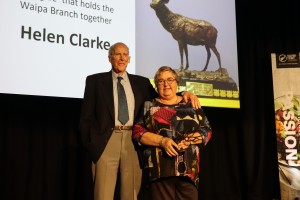
A surprised Helen Clarke received the 2024 Matuschka Award from the man behind the trophy Murray Matushka. “I don’t want thanks for what I do,” said Clarke. “I really love it, the deer industry is everything to us.”
Clarke, a member of the NZDFA Waipa/King Country deer farmers group for over 30 years, is the chair and driving force of the Waipa Advance Party and the go to person when the North Island Velvet Competition comes to town.
She took on the successful resurrection of the Rising Stars Hard Antler and Velvet competitions in both 2023 and 2024, among other things, while also managing to find spare time to volunteer at the Ōtorohanga Citizen’s Advice Bureau.
Testimonials to her work and organisational skills praised Clarke as “conscientious, thorough and steadfastly loyal,” and that her contribution was done “with humility” earning her “respect amongst her fellow deer farmers.”
This is the twenty-eighth time the Matuschka award has been presented to a grassroots farmer and unsung contributor to local area activities, functions and the core spirit of deer farming. It was also announced that Matuschka would be passing the baton on to Barry McIntosh once he is no longer able to present the award.
Dancing Dundas Creek Stags win top Deer Industry Photography award
Kirsten Roe was the winner of the 2024 Deer Industry Photography award for her image of two Dundas Creek stags facing off during the roar (picture).
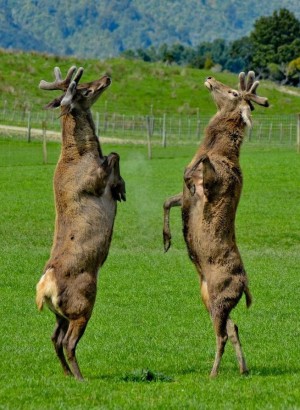 Roe was up against stiff competition, with six highly commended images from talented deer photographers Grant Charteris, Glenys Travers, Mike Thomas, Gordon Murray and two images from Sophie Hansen.
Roe was up against stiff competition, with six highly commended images from talented deer photographers Grant Charteris, Glenys Travers, Mike Thomas, Gordon Murray and two images from Sophie Hansen.
Announcing the winner, Sam Higgins, of the competition’s sponsor MSD, recalled a conversation with previous Deer Industry News editor Phil Stewart, which had originally sparked the idea of an industry photo competition. The rest was history, he said, adding he was pleased to see 83 entrants this year.
A new category, for Elk and Wapiti, was added this year, with Tony Pidgeon’s ‘Sunset Bull' being announced as the inaugural category winner by Elk & Wapiti Society president Grant Hasse.
“The People” chose Mike Thomas’ photo of a stag ‘Make Me’ as their favourite shot.

